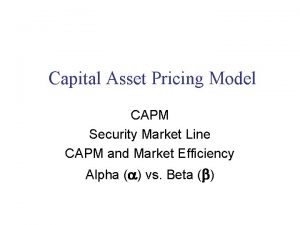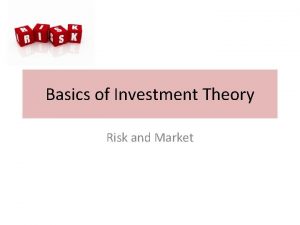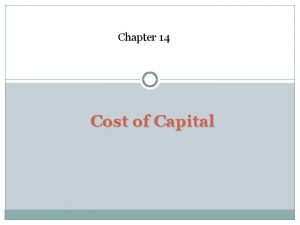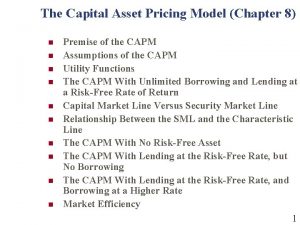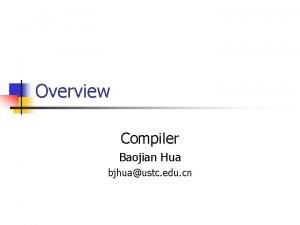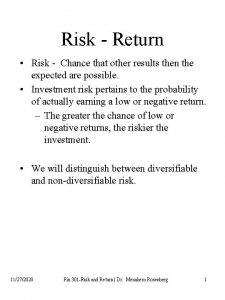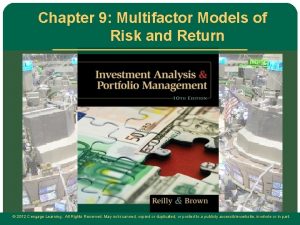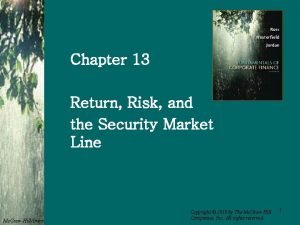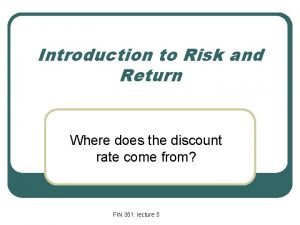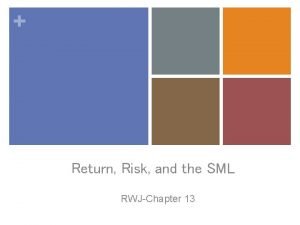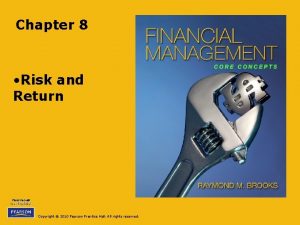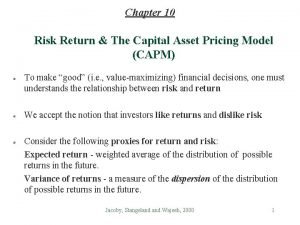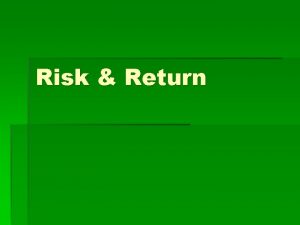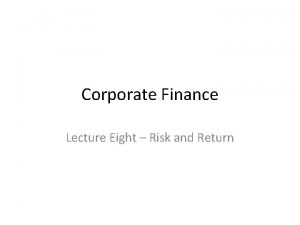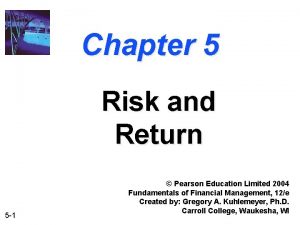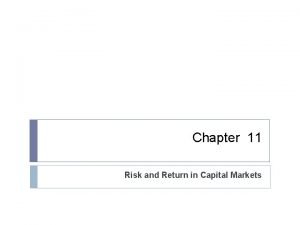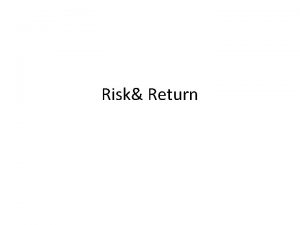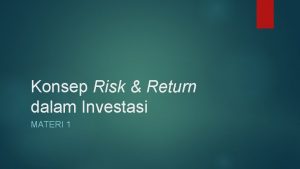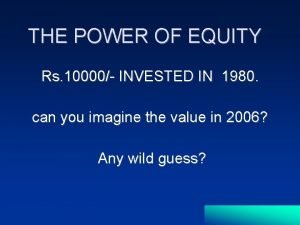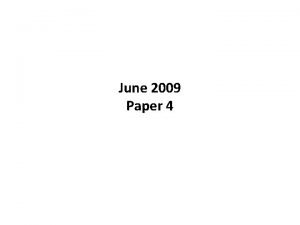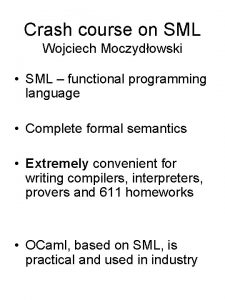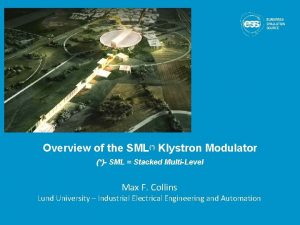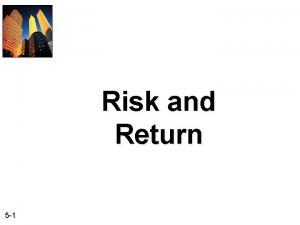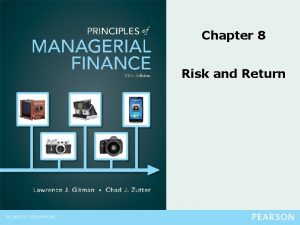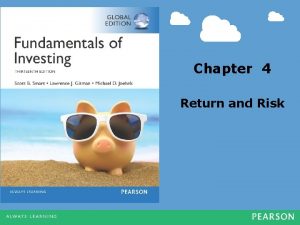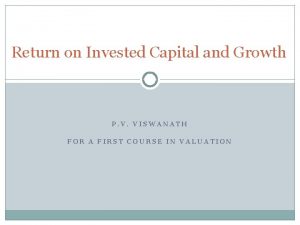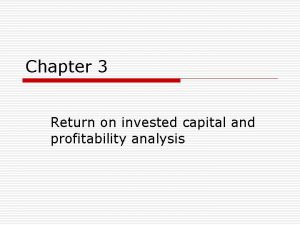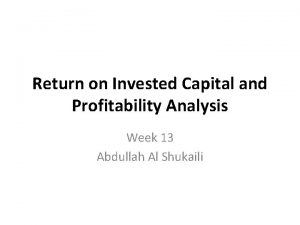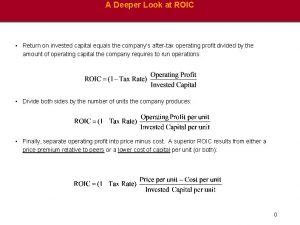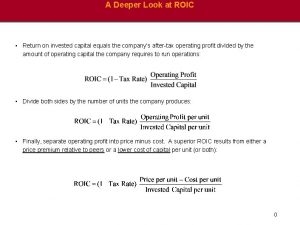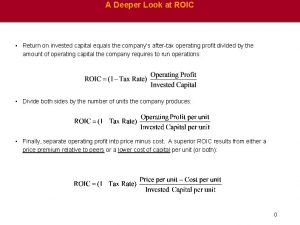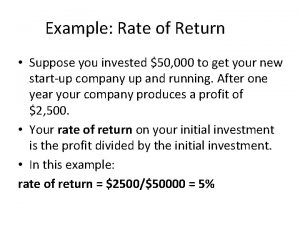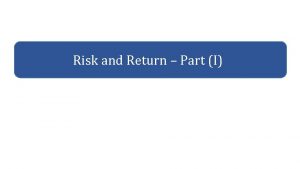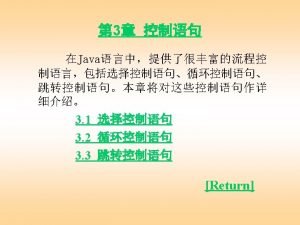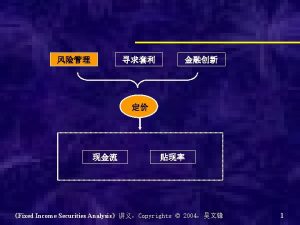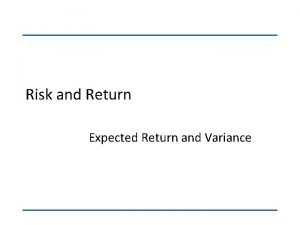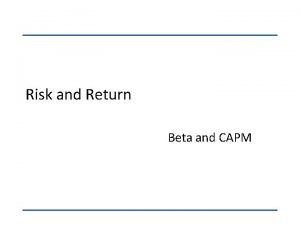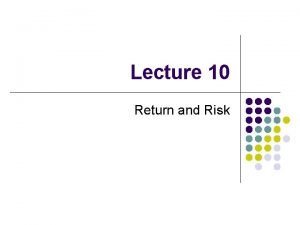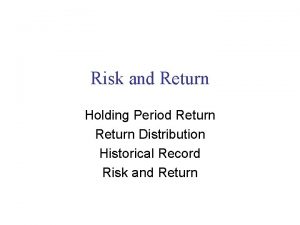Return Risk and SML Part I 1 Invested




























- Slides: 28

Return, Risk, and SML Part I

$1 Invested in Different Portfolios Return, Risk, and SML 2

Large Company Stocks Return, Risk, and SML 3

Small Company Stocks Return, Risk, and SML 4

Average Return, Risk, and SML 5

Example 1) Return, Risk, and SML 6

Example 2) • You find a certain stock that had returns of 12. 8%, – 21. 4%, 27. 4%, and 18. 4% for four of the last five years. Assume the average return of the stock over this period was 10. 80%. What was the stock’s return for the missing year? Return, Risk, and SML 7

Risk Premium • Risk-free return • Measures the time value of money for certain period • Treasury bill is free of any default risk over its short life, so its return is in practice used as risk-free return • Risk premium • Additional return we earn by moving from a relatively risk-free investment to a risky one • Excess return = Return – Risk-free return Return, Risk, and SML 8

Risk Premium Investment Return, Risk, and SML Average Risk Return Premium Large Company Stocks 11. 7% 8. 0% Small Company Stocks 16. 5% 12. 0% Long-term Corporate Bonds 6. 4% 2. 7% Long-term Government Bonds 5. 8% 2. 1% U. S. Treasury Bills 3. 7% 0 9

First Lesson • Risky assets, on average, earn a risk premium • There is a reward for bearing risk • What determines the relative size of the risk premium for the difference assets? Return, Risk, and SML 10

Example 3) Consider the following table for a period of six years. Calculate the observed risk premium in each year for the large-company stocks versus the T-bills. What was the average risk premium over this period? Return, Risk, and SML 11

Frequency Distiribution Return, Risk, and SML 12

Historical Variance and Standard Deviation • How volatile the return is? • Variance measures the average squared difference between the actual returns and the average return • Standard deviation is the square root of variance • The larger the variance or standard deviation is, the more spread out the returns will be Return, Risk, and SML 13

Example 4) Return, Risk, and SML 14

Historical Variance and Standard Deviation Return, Risk, and SML 15

Historical Standard Deviation Investment Large Company Stocks 8. 0% 20. 3% Small Company Stocks 12. 0% 32. 5% Long-term Corporate Bonds 2. 7% 8. 4% Long-term Government Bonds 2. 1% 9. 5% 0 3. 1% U. S. Treasury Bills Return, Risk, and SML Risk Standard Premium Deviation 16

Second Lesson • Bearing risk is handsomely rewarded, but, in a given year, there is a significant chance of a dramatic change in value • The greater the potential reward, the greater is the risk Return, Risk, and SML 17

Efficient Capital Markets • Prices change because new information arrives, and investors reassess asset value based on the information • Whether price adjust quickly and correctly when new information arrives? • Efficient capital market • Current market price fully reflect available information • There is no reason to believe that the current price is too low or too high Return, Risk, and SML 18

Price Behavior Return, Risk, and SML 19

Efficient Market Hypothesis • EMH does not mean that you can’t make money • EMH does mean that: • On average, you will earn a return appropriate for the risk undertaken • There is no bias in prices that can be exploited to earn abnormal returns • Market efficiency will not protect you from wrong choices Return, Risk, and SML 20

Forms of Market Efficiency • Strong form Efficient Market: • Information = Public or private • “Insider information” is of little use • Semi-strong form Efficient Market: • Information = Public (e. g. , trading information, annual reports, press releases) • Using financial statement to identify mispriced stocks is of little use • Weak form Efficient Market: • Information = Past (historical data) • Searching patterns in historical prices to identify mispriced stocks is of little use Return, Risk, and SML 21

Expected Return State of Probability of Stock Returns if State Economy State of Economy Occurs Stock A Stock B Boom 50% 0. 70 0. 10 Recessio 50% -0. 20 0. 30 n • Which one would you like? Return, Risk, and SML 22

Expected Return, Risk, and SML 23

Example 5) Consider the following information: State of Econom y Recessi on Normal Boom Calculate the expected return. Return, Risk, and SML Probability of State of Economy 0. 22 Stock Returns if State Occurs 0. 48 0. 30 0. 14 0. 33 -0. 12 24

How Volatile Stock Return Is? • Variance measures the average squared difference between the actual returns and the expected return • Standard deviation is the square root of variance • The larger the variance or standard deviation is, the more spread out the returns will be Return, Risk, and SML 25

Variance and Standard Deviation Return, Risk, and SML 26

Example 6) Return, Risk, and SML 27

Example 7) Consider the following information: State of Probability of Stock Returns if State Economy State of Economy Occurs Stock A Stock B Boom 0. 24 0. 055 -0. 34 Normal 0. 64 0. 135 0. 24 Recessio 0. 12 0. 230 0. 47 n Calculate the expected return and standard deviation for two stocks Return, Risk, and SML 28
 Noa turnover
Noa turnover Credit risk market risk operational risk
Credit risk market risk operational risk Cov(ri rm)
Cov(ri rm)![Rs=rf+βs(e[rm]-rf) is the _______. Rs=rf+βs(e[rm]-rf) is the _______.](data:image/svg+xml,%3Csvg%20xmlns=%22http://www.w3.org/2000/svg%22%20viewBox=%220%200%20200%20200%22%3E%3C/svg%3E) Rs=rf+βs(e[rm]-rf) is the _______.
Rs=rf+βs(e[rm]-rf) is the _______. Sml line
Sml line Market risk basics
Market risk basics The following are disadvantages of the sml approach
The following are disadvantages of the sml approach Capm assumption
Capm assumption Sml online compiler
Sml online compiler Cost efficient capital market
Cost efficient capital market Risk and return
Risk and return Market risk examples
Market risk examples Risk and return
Risk and return Multifactor model of risk and return
Multifactor model of risk and return Financial management chapter 8 risk and return
Financial management chapter 8 risk and return Chapter 13 return risk and the security market line
Chapter 13 return risk and the security market line Introduction to risk and return
Introduction to risk and return Risk and return
Risk and return Chapter 8 risk and rates of return problem solutions
Chapter 8 risk and rates of return problem solutions Capital market line
Capital market line Contoh diversifiable risk
Contoh diversifiable risk Difference between risk and return
Difference between risk and return Chapter 5 risk and return
Chapter 5 risk and return Difference between risk and return
Difference between risk and return Risk and return
Risk and return Konsep risk and return
Konsep risk and return Wipro 10000 investment in 1980
Wipro 10000 investment in 1980 Jaspir invested £2400 for n years
Jaspir invested £2400 for n years Mr johnson borrowed 8000 for 4 years
Mr johnson borrowed 8000 for 4 years
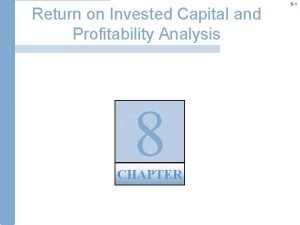

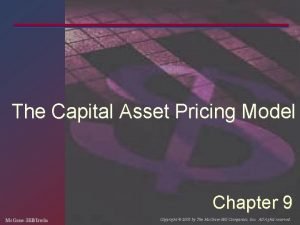
![Rs=rf+βs(e[rm]-rf) is the _______. Rs=rf+βs(e[rm]-rf) is the _______.](https://slidetodoc.com/wp-content/uploads/2020/09/109006_22147217b84d4adac39d40a26fd7205a-300x225.jpg)
